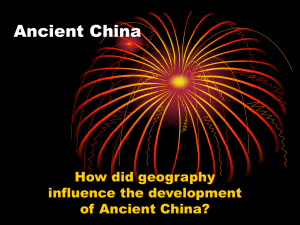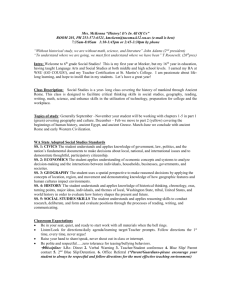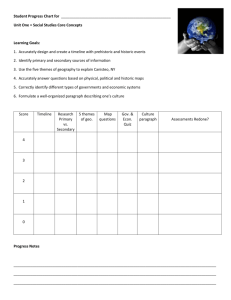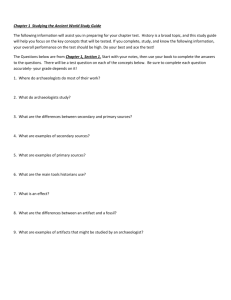Activities to Assess Learning Progress
advertisement
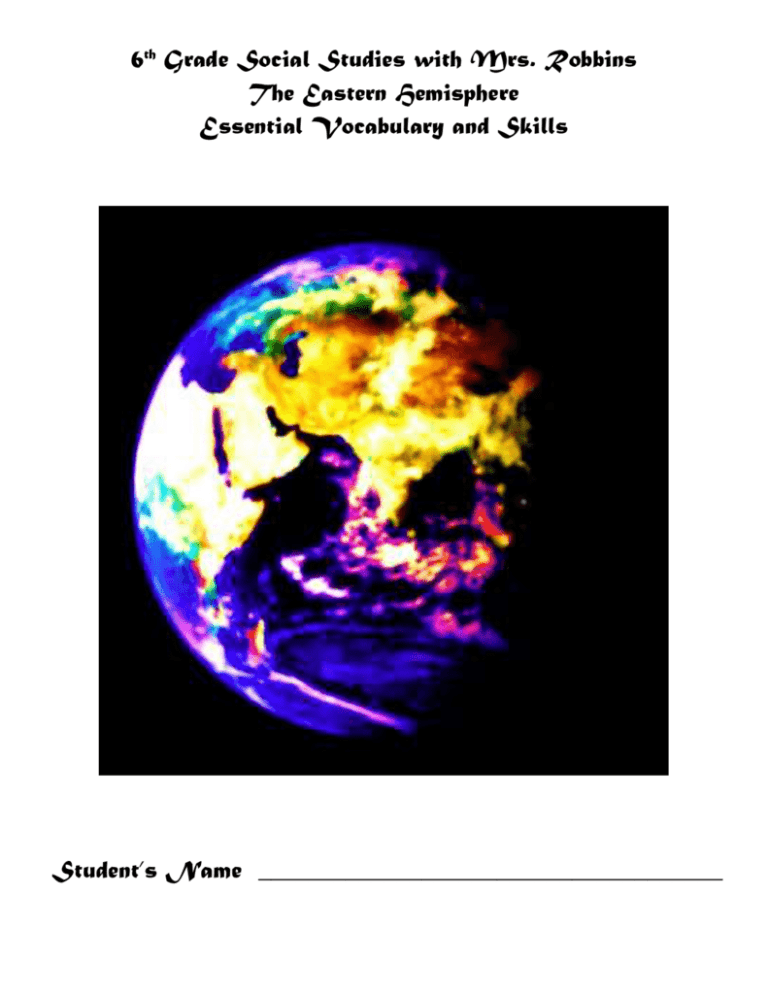
6th Grade Social Studies with Mrs. Robbins The Eastern Hemisphere Essential Vocabulary and Skills Student’s Name _____________________________________ Unit One: Social Studies Core Concepts Vocabulary Hemisphere Continents Oceans Latitude Longitude Physical Maps Political Maps Topography Culture Religion Government Political systems Social Economics Timeline A.D. B.C. B.C.E. C.E. Old Stone Age Middle Stone Age New Stone Age Ancient Civilization Prehistory History Population Primary Source Secondary Source Activities to Assess Learning Progress Use the five themes of geography to explain Canisteo, NY Accurately design and create a timeline with prehistoric and historic events Identify primary and secondary sources of information Accurately answer questions based on physical, political and historic maps Correctly identify different types of governments and economic systems Formulate a well-organized paragraph describing one’s culture 2 Unit Two: Fertile Crescent Vocabulary Asia Europe Middle East Africa Indian Ocean Tigris River Euphrates River Ziggurats Polytheism Monotheism Empires Mesopotamia Artifacts Archeology Archeologist Sumer Cuneiform Script Phoenicians Babylonia Code of Hammurabi Israelites Judaism Agriculture Activities to Assess Learning Progress Name and locate Fertile Crescent geography vocabulary on various maps. Analyze artifacts to explain cultures. Answer with evidence: How does geography affect peoples’ culture? Answer with evidence: What are the consequences of technology? Compare and contrast Sumerian Cuneiform Script and Phoenician Alphabet. Plot Mesopotamian events on a timeline Explain and/or demonstrate vocabulary verbally and/or in written form. 3 Unit Three: Ancient Greece Vocabulary Peninsula Island Mountain Mediterranean Sea Europe Asia Africa Middle East Acropolis City State Dark Ages Aristocracy Aristocrats Tyrant Democracy Direct Democracy Representative Democracy Athens Sparta Pericles Architecture Parthenon Trojan War Myth Epic Iliad & Odyssey Olympian gods Immortal Olympics Philosophers Greek Tragedies Greek Comedies Peloponnesian war Plague Activities to Assess Learning Progress Name and locate ancient Greece geography vocabulary on various maps. Plot ancient Greek events on a timeline Answer with evidence: What is Power? Who should have it? Explain and/or demonstrate vocabulary verbally and/or in written form. Debate whether Athens or Sparta was “better” using political, social, and economic evidence. 4 Unit Four: Ancient Rome Vocabulary Mediterranean Sea Europe Asia Africa Italy Peninsula Tiber River Romulus & Remus Toga Republic Constitution Checks and Balances Veto Senate Plebeians Patricians Consuls Julius Caesar Civil War Architecture Aqueducts Latin Mosaic Colosseum Gladiator Christianity Activities to Assess Learning Progress Name and locate Ancient Rome geography vocabulary on various maps. Plot ancient Roman events on a timeline Answer with evidence: Why do great civilizations collapse? Explain and/or demonstrate vocabulary verbally and/or in written form. 5 Unit Five: Ancient Egypt Vocabulary Nile River Nile Delta Africa Mediterranean Sea Red Sea Silt Pharaoh Dynasty Polytheism Pyramids Hieroglyphs Mummification Anatomy Astronomers Papyrus Hieroglyphic Artisans Activities to Assess Learning Progress Name and locate Ancient Egyptian geography vocabulary on various maps. Plot ancient Egyptian events on a timeline Answer with evidence: How does geography affect the culture of civilizations? Explain and/or demonstrate vocabulary verbally and/or in written form. 6 Unit Six: Ancient India Vocabulary Himalaya Mountains Monsoons Ganges River Indus River Valley Indian Ocean Caste System Hinduism Reincarnation Eight Fold Path Nirvana Avatars Brahman Dharma Ahimsa Activities to Assess Learning Progress Name and locate ancient India geography vocabulary on various maps. Plot ancient Indian events on a timeline Answer with evidence: How are religion and culture connected? Explain and/or demonstrate vocabulary verbally and/or in written form. Analyze the historical relevance of the book titled Homeless Birds. 7 Unit Seven: Ancient China Vocabulary Huang He (Yellow) River Chang Jiang River Yangzi Rivers Himalayas Taklimakan Desert Gobi Desert Plateau Pacific Ocean Asia Monsoons Middle Kingdom Buddhism Han Dynasty Emperor Wudi Shang Dynasty Terra Cotta Army Extended family Confucius Philosopher/ Philosophy Shi Huangdi Great Wall Silk Road Calligraphy Activities to Assess Learning Progress Name and locate ancient China geography vocabulary on various maps. Answer with evidence: What distinguishes one culture from another? Answer with evidence: What should governments do? Plot ancient Chinese civilization events on a timeline Compare and contrast Hinduism and Buddhism Write using calligraphy. Explain and/or demonstrate vocabulary verbally and/or in written form. 8 Unit Eight: Medieval Europe Vocabulary Europe Asia Mediterranean Sea Atlantic Ocean Alps Britain France Germany Italy Middle Ages Charlemagne Monasteries St. Patrick Catholic Vikings Feudalism King Lords Vassals Knights Chivalry Manor Castles Serf Pope Crusade Joan of Arc Bubonic Plague Renaissance Activities to Assess Learning Progress Name and locate Medieval Europe geography vocabulary on various maps. Answer with evidence: Why do political maps change over time? Plot Medieval European events on a timeline Explain and/or demonstrate vocabulary verbally and/or in written form. 9 Evidence of Learning Finalize Individual Learning Progress Activities by the end of each marking period. Master 6th Grade Social Studies Unit Exams by the end of each marking period. Finalize Museum Exhibits for each Unit by the end of April. Master 6th grade Student Learning Objective with a cumulative assessment by the end of May. 10

